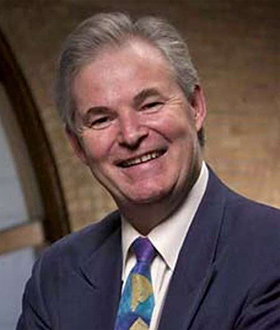A. Richard Newton facts for kids
Quick facts for kids
A. Richard Newton
|
|
|---|---|

Arthur Richard Newton (1951–2007)
|
|
| Born | 1 July 1951 Gardenvale, Australia
|
| Died | 2 January 2007 (aged 55) San Francisco, US
|
| Nationality | Australian, American |
| Alma mater | University of Melbourne University of California Berkeley |
| Known for | Circuit design CAD |
| Awards | Phil Kaufman Award |
| Scientific career | |
| Fields | Electronic Engineer |
| Institutions | University of California Berkeley |
| Doctoral advisor | Donald O. Pederson |
Arthur Richard Newton was a very important engineer and a leader at the University of California, Berkeley. He was born in Melbourne, Australia, on July 1, 1951. He later became the dean of the College of Engineering at Berkeley. He passed away on January 2, 2007.
Contents
A Journey in Engineering
Arthur Richard Newton started his education at the University of Melbourne in Australia. He earned his first engineering degree in 1973 and a master's degree in 1975.
Developing SPICE
In 1975, he moved to the University of California, Berkeley. There, he worked on a special computer program called SPICE. SPICE stands for "Simulation Program with Integrated Circuit Emphasis." It was created to help engineers design and test complex electronic circuits quickly and accurately. Many people believe that almost all electronic integrated circuits (tiny computer chips) have been designed using SPICE or similar programs since the 1980s. This shows how important his work was!
Becoming a Professor and Dean
Berkeley awarded Newton his PhD in 1978. After that, he was offered a rare position as a professor at the university. He became an assistant professor in 1978, an associate professor in 1982, and a full professor in 1985. From 1999 to 2000, he led the Department of Electrical Engineering and Computer Sciences. Then, from 2000 until his passing, he served as the dean of the College of Engineering.
Robert Birgeneau, who was Berkeley's leader (called the Chancellor), spoke highly of Newton. He said Newton was "dynamic and entrepreneurial." This means he was full of energy and good at creating new things. He understood how engineering and technology could solve big problems in the world.
About His Life
Arthur Newton was born in 1951 in Gardenvale, Victoria, Australia. His parents were Rodger and Bette Newton. He was married to Petra Michel, and they had two daughters.
He passed away at age 55 in San Francisco.
Remembering His Impact
Many organizations created special honors and awards to remember A. Richard Newton and his contributions.
Memorial Professorship
In February 2007, Berkeley created the Dean A. Richard Newton Memorial Professorship. This special teaching position honors him. It helps advance the field of synthetic biology, which is about designing new biological systems. Newton was very interested in this new area.
Microsoft Academic Award
In July 2007, Microsoft announced an academic award program. This award supports new and creative uses of information technology. It was inspired by Newton's ideas and his long-time work with Microsoft Research.
Engineering Design Awards
Two important engineering groups, the IEEE Council on Electronic Design Automation and the ACM Special Interest Group on Design Automation, created the ACM/IEEE A. Richard Newton Technical Impact Award. This yearly award celebrates amazing technical achievements in electronic design. It was first given out in 2009.
The Design Automation Conference also created the A. Richard Newton Graduate Scholarship. This scholarship helps students who are studying and researching design automation. It was first awarded in 2008.
Encouraging Women in Tech
The Anita Borg Institute for Women and Technology established the A. Richard Newton Educator Award. This award recognizes teachers who use innovative methods to encourage girls and women to study engineering, science, and mathematics. It honors Newton's efforts to support women in technology. This award was first given in 2011.
Awards and Recognition
Arthur Richard Newton received many honors during his life.
- He received the Phil Kaufman Award in 2003.
- The University of Melbourne awarded him an honorary law degree (LLD) in 2003.
- He became a member of the National Academy of Engineering in 2004.
- In 2006, he was named to the American Academy of Arts and Sciences.

